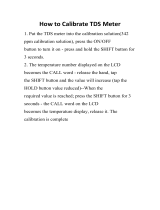
12
OPERATIONAL GUIDE
pH MEASUREMENT & CALIBRATION
Make sure the meter has been calibrated before use.
If the probe is dry, soak it in HI70300 storage solution
for 30 minutes to reactivate it. If
soiled, clean the electrode by soaking
in cleaning solution for 20 minutes,
then rinse the tip and soak in storage
solution at least 30 minutes before use.
Rinse the electrode well and shake off excess droplets.
Recalibrate before using. Submerge the probe in the sample
to be tested while stirring it gently. Wait until the
tag
on the LCD disappears.
The LCD displays the pH value (automatically compensated
for temperature) on the primary LCD, the EC, TDS or pH‑mV
value on the secondary LCD, while the tertiary LCD line
displays the sample temperature. If measurements are
taken in different samples successively, rinse the probe tip
thoroughly in distilled or deionized water to eliminate cross‑
contamination. For better accuracy, frequent calibration of
the pH sensor with the meter is recommended. In addition,
the meter must be recalibrated:
a) whenever the pH electrode is replaced.
b) after testing aggressive chemicals.
c) when high accuracy is required.
d) at least once a month.
e) after cleaning the sensor.
pH calibration
Select calibration type “STD“
. Place
the sensor into the first calibration buffer.
If performing a two‑point calibration, use
pH 7.01 (pH 6.86 for NIST) buffer first.
The meter will enter the calibration mode, displaying “pH 7.01
USE” and tag blinking (or “pH 6.86 USE” for NIST).
Follow directions for single and two‑point calibration below:
Single-point calibration
1. Place the probe in any buffer from the selected buffer
set. The meter will automatically recognize the buffer value.
2. If the buffer is not recognized or the calibration offset























